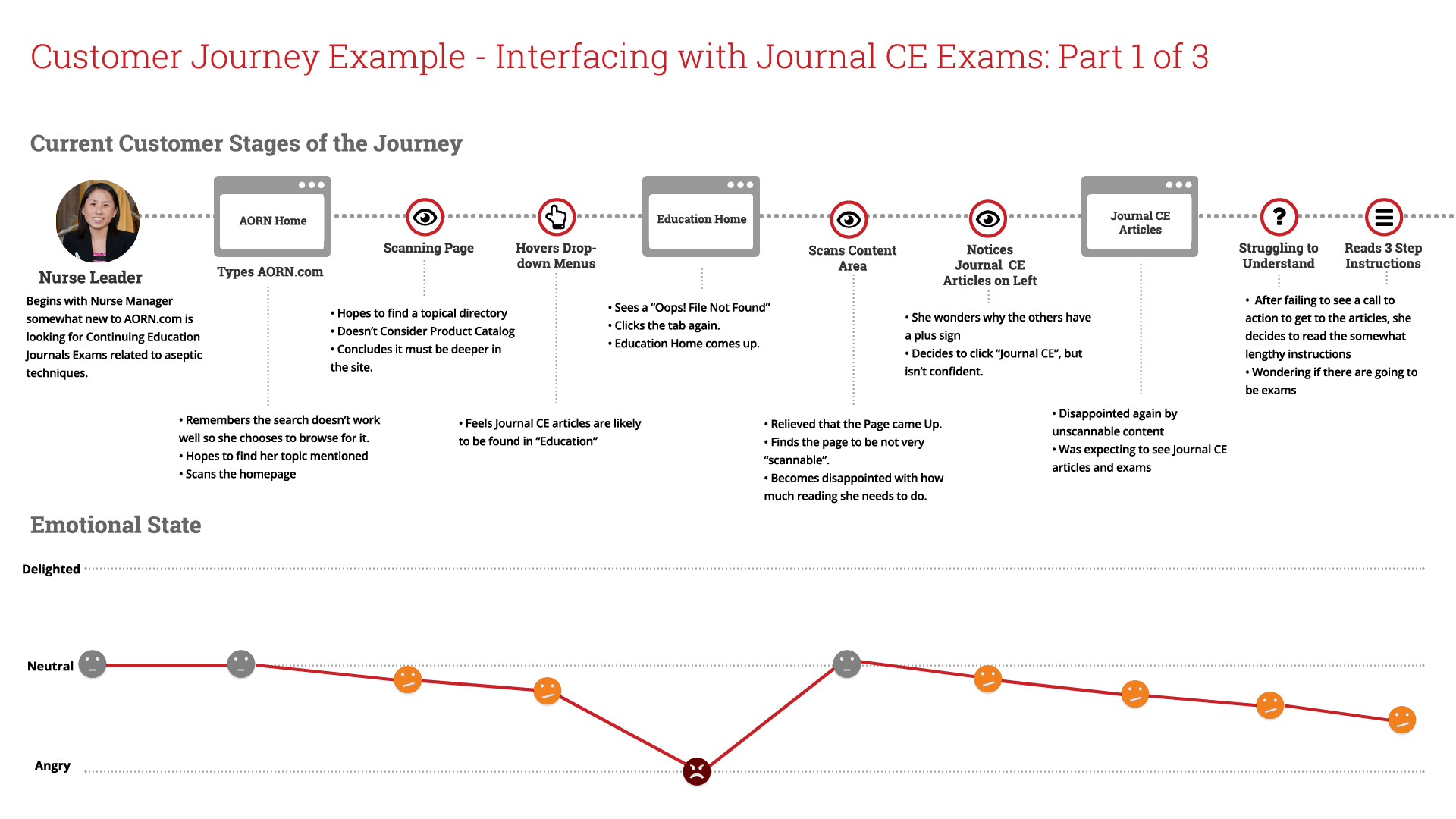If you don’t know what a customer journey is, in short, a customer journey map is a holistic visualization of a customers’ objectives, needs, feelings, and barriers plotted along key touchpoints while interacting with a product or service. Creating a customer journey map may seem daunting, but it may not be as difficult and expensive as you may think.
I wanted to first provide a breakdown of the elements a customer journey map, and then illustrate how low the barrier to entry for customer journey maps actually is.
A great journey map documents the customer experience from_the customer's eyes, helping businesses to understand not only how the_customer interacts with them today, but also provides a framework for identifying improvement opportunities.
Here’s an example journey map.

The Benefits of a Customer Journey Maps
The best way is to understand the benefits is to understand by comparing and contrasting it to a traditional research approach.
| Customer Journey Approach | Traditional Research Approach |
|---|---|
|
|
Elements of a Customer Journey Map
We can break a customer journey into four main elements with optional elements that can be added.
Four Main Elements
- A Timeline is an established time frame which in general is hypothetical. It may start from a person watching a TV commercial and end with a customer calling support after he/she has purchased a product.
- Touchpoints are distinct points plotted along a timeline, where a customer interacts with a brand. This includes experiences like tipping a waiter on a phone app or talking to the cashier about the weather. Touchpoints can be grouped into phases such as researching, buying, and getting support.
- Personas are fictional, yet realistic, descriptions of a typical or target users/customers of a website, product or service. A persona is an archetype instead of an actual living human, but can and should be described as if they were real people.
- Empathy Mapping is a visual depiction of a person’s subjective experiences, which may include thinking, feeling and/or doing.
Optional Elements
Depending on the goals of doing the exercise, you may want to add on other elements such as how various departments are related to a given touchpoint.
- Other empathetic points such as satisfaction, level of effort to complete task, time to complete task, sights, sounds, thought process etc.
- Opportunities such as ideas to improve a touchpoint or boost sales.
- Channels such as social media, a retail website, Google or retail locations can be plotted
- Customer Goals can be plotted to identify the customer(s)’s intent
- “Behind the Scenes” such as people, processes and technologies related to touchpoints. Tools such as ERPs and other factors that are not visible to the customer. This can help for the following reasons:
- Help identify the real influencers of the customer experiences
- Expose root causes of customer experience problems
- Enlighten employees and stakeholders how they affect the customer journey.
Scaling the Process
A Customer Journey map at the easiest level can be a 100% assumptive-based workshop conducted using stickies. The timeline, the touchpoints, the personas, and the empathy mapping can all be done in a 2-hour workshop. Afterwards the brainstorm of notes and stickies can be synthesized and handed off to a designer, which may take another 2 working days.
To produce a more research-based customer journey map can take more time because for two main reasons:
- Conducting Ethnographic Studies: Your mapping deliverable may involve doing one or more ethnographic studies (a.k.a). contextual interviews. Ethnographic studies involve interviewees being observed in their own environment, when doing their tasks, with as little interference from the interviewer as possible. While the result findings are qualitative and observational, contextual interviews can unveil the users’ environment, the actual technology they are working with, and how long it takes for the to complete certain tasks. Some other alternative to this research is to ask participants.
- Research-Based Personas: Assumptive-based personas can be developed mostly quite easily by doing some light research and conducting a workshop. Research-based personas qualitative and/or quantitative data, then synthesized through insights gathered through the research. It is more time-consuming and costly The table example below shows a range of how easy or complex the process can get. Of course, you may pick a solution that is somewhere in the middle as well.
| Activity | Low End | Higher End |
|---|---|---|
| Personas Development | Limited to 1 Persona 30-min workshop time |
|
| Timeline & Touchpoints | 30-min workshop time |
|
| Empathy Mapping | 30-min workshop time |
|
| Optional Elements | None |
|
| TOTAL TIME | 2 hours of 6-10 resources 4 hours of design time |
|
 Kenneth Lee
Kenneth Lee